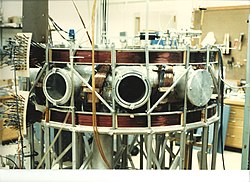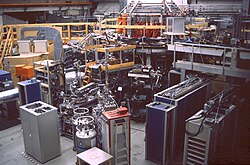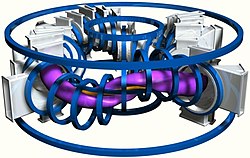| Device name [1] | Status | Construction | Operation | Location | Organisation | Major/minor radius | B-field | Plasma current | Purpose | Image |
|---|
| T-1 (Tokamak-1) [2] | Shut down | 1957 | 1958–1959 |  Moscow Moscow | Kurchatov Institute | 0.625 m/0.13 m | 1 T | 0.04 MA | First tokamak |  |
| T-2 (Tokamak-2) [2] | Recycled →FT-1 | 1959 | 1960–1970 |  Moscow Moscow | Kurchatov Institute | 0.62 m/0.22 m | 1 T | 0.04 MA | | |
| T-3 (Tokamak-3) [2] | Shut down | 1960 | 1962–? |  Moscow Moscow | Kurchatov Institute | 1 m/0.12 m | 3.5 T | 0.15 MA | Overcame Bohm diffusion by a factor of 10, temperature 10 MK, confinement time 10 ms | |
| T-5 (Tokamak-5) [2] | Shut down | ? | 1962–1970 |  Moscow Moscow | Kurchatov Institute | 0.625 m/0.15 m | 1.2 T | 0.06 MA | Investigation of plasma equilibrium in vertical and horizontal direction | |
| TM-1 | Shut down | ? | ? |  Moscow Moscow | Kurchatov Institute | | | | | |
| TM-2 | Shut down | ? | 1965 |  Moscow Moscow | Kurchatov Institute | | | | | |
| TM-3 | Shut down | ? | 1970 |  Moscow Moscow | Kurchatov Institute | | | | | |
| FT-1 [2] | Recycled →CASTOR | T-2 | 1972–2002 |  Saint Petersburg Saint Petersburg | Ioffe Institute | 0.62 m/0.22 m | 1.2 T | 0.05 MA | | |
| ST (Symmetric Tokamak) | Shut down | Model C | 1970–1974 |  Princeton Princeton | Princeton Plasma Physics Laboratory | 1.09 m/0.13 m | 5.0 T | 0.13 MA | First American tokamak, converted from Model C stellarator | |
| T-6 (Tokamak-6) | Shut down | ? | 1970–1974 |  Moscow Moscow | Kurchatov Institute | 0.7 m/0.25 m | 1.5 T | 0.22 MA | | |
| TUMAN-2, 2A | Shut down | ? | 1971–1985 |  Saint Petersburg Saint Petersburg | Ioffe Institute | 0.4 m/0.08 m | 1.5 T | 0.012 MA | | |
| ORMAK (Oak Ridge tokaMAK) | Shut down | | 1971–1976 |  Oak Ridge Oak Ridge | Oak Ridge National Laboratory | 0.8 m/0.23 m | 2.5 T | 0.34 MA | First to achieve 20 MK plasma temperature |  |
| Doublet II | Shut down | | 1972–1974 |  San Diego San Diego | General Atomics | 0.63 m/0.08 m | 0.95 T | 0.21 MA | | |
| ATC (Adiabatic Toroidal Compressor) | Shut down | 1971–1972 | 1972–1976 |  Princeton Princeton | Princeton Plasma Physics Laboratory | 0.88 m/0.11 m | 2 T | 0.05 MA | Demonstrate compressional plasma heating |  |
| T-9 (Tokamak-9) | Shut down | ? | 1972–1977 |  Moscow Moscow | Kurchatov Institute | 0.36 m/0.07 m | 1 T | | | |
| TO-1 | Shut down | ? | 1972–1978 |  Moscow Moscow | Kurchatov Institute | 0.6 m/0.13 m | 1.5 T | 0.07 MA | | |
| Alcator A (Alto Campo Toro) | Shut down | ? | 1972–1978 |  Cambridge Cambridge | Massachusetts Institute of Technology | 0.54 m/0.10 m | 9.0 T | 0.3 MA | | |
| JFT-2 (JAERI Fusion Torus 2) | Shut down | ? | 1972–1982 |  Naka Naka | Japan Atomic Energy Research Institute | 0.9 m/0.25 m | 1.8 T | 0.25 MA | | |
| Turbulent Tokamak Frascati (TTF, torello) | Shut down | | 1973 |  Frascati Frascati | ENEA | 0.3 m/0.04 m | 1 T | 0.005 MA | Study of turbulent plasma heating | |
| Pulsator [3] | Shut down | 1970–1973 | 1973–1979 |  Garching Garching | Max Planck Institute for Plasma Physics | 0.7 m/0.12 m | 2.7 T | 0.125 MA | Discovery of high-density operation with tokamaks | |
| TFR (Tokamak de Fontenay-aux-Roses) | Shut down | | 1973–1984 |  Fontenay-aux-Roses Fontenay-aux-Roses | CEA | 0.98 m/0.2 m | 6 T | 0.49 MA | | |
| T-4 (Tokamak-4) [2] | Shut down | ? | 1974–1978 |  Moscow Moscow | Kurchatov Institute | 0.9 m/0.16 m | 5 T | 0.3 MA | Observed fast thermal quench before major plasma disruptions | |
| Doublet IIA | Shut down | | 1974–1979 |  San Diego San Diego | General Atomics | 0.66 m/0.15 m | 0.76 T | 0.35 MA | | |
| Petula-B | Shut down | ? | 1974–1986 |  Grenoble Grenoble | CEA | 0.72 m/0.18 m | 2.7 T | 0.23 MA | | |
| T-10 (Tokamak-10) [2] | Operational | | 1975– |  Moscow Moscow | Kurchatov Institute | 1.50 m/0.37 m | 4 T | 0.8 MA | Largest tokamak of its time |  |
| T-11 (Tokamak-11) | Shut down | ? | 1975–1984 |  Moscow Moscow | Kurchatov Institute | 0.7 m/0.25 m | 1 T | | | |
| PLT (Princeton Large Torus) | Shut down | 1972–1975 | 1975–1986 |  Princeton Princeton | Princeton Plasma Physics Laboratory | 1.32 m/0.42 m | 4 T | 0.7 MA | First to achieve 1 MA plasma current |  |
| Divertor Injection Tokamak Experiment (DITE) | Shut down | | 1975–1989 |  Culham Culham | United Kingdom Atomic Energy Authority | 1.17 m/0.27 m | 2.7 T | 0.26 MA | | |
| JIPP T-II | Shut down | ? | 1976 |  Nagoya Nagoya | Nagoya University | 0.91 m/0.17 m | 3 T | 0.16 MA | | |
| TNT-A | Shut down | ? | 1976 |  Tokyo Tokyo | Tokyo University | 0.4 m/0.09 m | 0.42 T | 0.02 MA | | |
| T-8 (Tokamak-8) [2] | Shut down | ? | 1976–? |  Moscow Moscow | Kurchatov Institute | 0.28 m/0.048 m | 0.9 T | 0.024 MA | First D-shaped tokamak | |
| Microtor [4] | Shut down | ? | 1976–1983? |  Los Angeles Los Angeles | UCLA | 0.3 m/0.1 m | 2.5 T | 0.12 MA | Plasma impurity control and diagnostic development | |
| Macrotor [4] | Shut down | ? | 1970s–80s |  Los Angeles Los Angeles | UCLA | 0.9 m/0.4 m | 0.4 T | 0.1 MA | Understanding plasma rotation driven by radial current | |
| TUMAN-3 [2] | Operational | ? | 1977–
(1990–, 3M) |  Saint Petersburg Saint Petersburg | Ioffe Institute | 0.55 m/0.23 m | 3 T | 0.18 MA | Study adiabatic compression, RF and NB heating, H-mode and parametric instability | |
| Thor [5] | Shut down | | ? |  Milano Milano | University of Milano | 0.52 m/0.195 m | 1 T | 0.055 MA | | |
| FT (Frascati Tokamak) | Shut down | | 1978 |  Frascati Frascati | ENEA | 0.83 m/0.20 m | 10 T | 0.8 MA | | |
| PDX (Poloidal Divertor Experiment) | Shut down | ? | 1978–1983 |  Princeton Princeton | Princeton Plasma Physics Laboratory | 1.4 m/0.4 m | 2.4 T | 0.5 MA | | |
| ISX-B | Shut down | ? | 1978–1984 |  Oak Ridge Oak Ridge | Oak Ridge National Laboratory | 0.93 m/0.27 m | 1.8 T | 0.2 MA | Attempt high-beta operation | |
| Doublet III | Shut down | | 1978–1985 |  San Diego San Diego | General Atomics | 1.45 m/0.45 m | 2.6 T | 0.61 MA | | |
| T-12 (Tokamak-12) | Shut down | ? | 1978–1985 |  Moscow Moscow | Kurchatov Institute | 0.36 m/0.08 m | 1 T | 0.03 MA | | |
| Alcator C (Alto Campo Toro) | Shut down | ? | 1978–1986 |  Cambridge Cambridge | Massachusetts Institute of Technology | 0.64 m/0.16 m | 13 T | 0.8 MA | | |
| T-7 (Tokamak-7) [2] | Recycled →HT-7 [6] | ? | 1979–1985 |  Moscow Moscow | Kurchatov Institute | 1.2 m/0.31 m | 3 T | 0.3 MA | First tokamak with superconducting toroidal field coils | |
| ASDEX (Axially Symmetric Divertor Experiment) [7] | Recycled →HL-2A | 1973–1980 | 1980–1990 |  Garching Garching | Max-Planck-Institut für Plasmaphysik | 1.65 m/0.4 m | 2.8 T | 0.5 MA | Discovery of the H-mode in 1982 | |
| FT-2 [2] | Operational | ? | 1980– |  Saint Petersburg Saint Petersburg | Ioffe Institute | 0.55 m/0.08 m | 3 T | 0.05 MA | H-mode physics, LH heating | |
| TEXTOR (Tokamak Experiment for Technology Oriented Research) [8] [9] | Shut down | 1976–1980 | 1981–2013 |  Jülich Jülich | Forschungszentrum Jülich | 1.75 m/0.47 m | 2.8 T | 0.8 MA | Study plasma-wall interactions | |
| TFTR (Tokamak Fusion Test Reactor) [10] | Shut down | 1980–1982 | 1982–1997 |  Princeton Princeton | Princeton Plasma Physics Laboratory | 2.4 m/0.8 m | 5.9 T | 3 MA | Attempted scientific break-even, reached record fusion power of 10.7 MW and temperature of 510 MK |  |
| Tokamak de Varennes (TdeV) | Shut down | ? | 1983–1997 |  Montreal Montreal | National Research Council Canada | 0.83 m/0.27 m | 1.5 T | 0.3 MA | [11] | |
| JFT-2M (JAERI Fusion Torus 2M) | Shut down | ? | 1983–2004 |  Naka Naka | Japan Atomic Energy Research Institute | 1.3 m/0.35 m | 2.2 T | 0.5 MA | | |
| JET (Joint European Torus) [12] | Shut down | 1978–1983 | 1983–2023 |  Culham Culham | United Kingdom Atomic Energy Authority | 2.96 m/0.96 m | 4 T | 7 MA | Records for fusion output power 16.1 MW (1997), fusion energy 69 MJ (2023) | 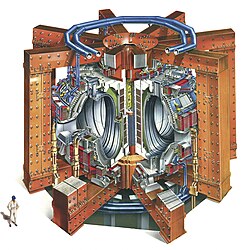 |
| Novillo [13] [14] | Shut down | NOVA-II | 1983–2004 |  Mexico City Mexico City | Instituto Nacional de Investigaciones Nucleares | 0.23 m/0.06 m | 1 T | 0.01 MA | Study plasma-wall interactions | |
| JT-60 (Japan Torus-60) [15] | Recycled →JT-60U | | 1985–1989 |  Naka Naka | Japan Atomic Energy Research Institute | 3 m/0.95 m | 4 T | 2.6 MA | High-beta steady-state operation, highest fusion triple product |  |
| CCT (Continuous Current Tokamak) | Shut down | ? | 1986–199? |  Los Angeles Los Angeles | UCLA | 1.5 m/0.4 m | 0.2 T | 0.05 MA | H-mode studies | |
| DIII-D [16] | Operational | 1986 [17] | 1986– |  San Diego San Diego | General Atomics | 1.67 m/0.67 m | 2.2 T | 3 MA | Tokamak Optimization | 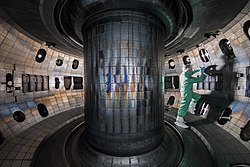 |
| STOR-M (Saskatchewan Torus-Modified) [18] | Operational | | 1987– |  Saskatoon Saskatoon | Plasma Physics Laboratory (Saskatchewan) | 0.46 m/0.125 m | 1 T | 0.06 MA | Study plasma heating and anomalous transport | |
| T-15 [2] | Recycled →T-15MD | 1983–1988 | 1988–1995 |  Moscow Moscow | Kurchatov Institute | 2.43 m/0.78 m | 3.6 T | 1 MA | First superconducting tokamak, pulse duration 1.5 s |  |
| Tore Supra [19] | Recycled →WEST | | 1988–2011 |  Cadarache Cadarache | Département de Recherches sur la Fusion Contrôlée | 2.25 m/0.7 m | 4.5 T | 2 MA | Large superconducting tokamak with active cooling | |
| ADITYA (tokamak) | Operational | | 1989– |  Gandhinagar Gandhinagar | Institute for Plasma Research | 0.75 m/0.25 m | 1.2 T | 0.25 MA | | |
| COMPASS (COMPact ASSembly) [20] [21] | Operational | 1980– | 1989– |  Prague Prague | Institute of Plasma Physics, Czech Academy of Sciences | 0.56 m/0.23 m | 2.1 T | 0.32 MA | Plasma physics studies for ITER |  |
| FTU (Frascati Tokamak Upgrade) | Operational | | 1990– |  Frascati Frascati | ENEA | 0.935 m/0.35 m | 8 T | 1.6 MA | | |
| START (Small Tight Aspect Ratio Tokamak) [22] | Recycled →Proto-Sphera | | 1990–1998 |  Culham Culham | United Kingdom Atomic Energy Authority | 0.3 m/? | 0.5 T | 0.31 MA | First full-sized Spherical Tokamak | |
| JT-60U (Japan Torus-60 Upgrade) | Shut down | 1989–1991 | 1991–2008 |  Naka Naka | Japan Atomic Energy Research Institute | 3.4 m/1.0 m | 4 T | 3 MA | investigate energy confinement near the breakeven condition | |
| ASDEX Upgrade (Axially Symmetric Divertor Experiment) | Operational | | 1991– |  Garching Garching | Max-Planck-Institut für Plasmaphysik | 1.65 m/0.5 m | 2.6 T | 1.4 MA | | 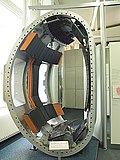 |
| Alcator C-Mod (Alto Campo Toro) [23] | Shut down | 1986– | 1991–2016 |  Cambridge Cambridge | Massachusetts Institute of Technology | 0.68 m/0.22 m | 8 T | 2 MA | Record plasma pressure 2.05 bar |  |
| ISTTOK (Instituto Superior Técnico TOKamak) [24] | Operational | | 1992– |  Lisbon Lisbon | Instituto de Plasmas e Fusão Nuclear | 0.46 m/0.085 m | 2.8 T | 0.01 MA | | |
| TCV (Tokamak à Configuration Variable) [25] | Operational | | 1992– |  Lausanne Lausanne | École Polytechnique Fédérale de Lausanne | 0.88 m/0.25 m | 1.43 T | 1.2 MA | Confinement studies |  |
| HBT-EP (High Beta Tokamak-Extended Pulse) | Operational | | 1993– |  New York City New York City | Columbia University Plasma Physics Laboratory | 0.92 m/0.15 m | 0.35 T | 0.03 MA | High-Beta tokamak |  |
| HT-7 (Hefei Tokamak-7) | Shut down | 1991–1994 (T-7) | 1995–2013 |  Hefei Hefei | Hefei Institutes of Physical Science | 1.22 m/0.27 m | 2 T | 0.2 MA | China's first superconducting tokamak | |
| Pegasus Toroidal Experiment [26] | Operational | ? | 1996– |  Madison Madison | University of Wisconsin–Madison | 0.45 m/0.4 m | 0.18 T | 0.3 MA | Extremely low aspect ratio |  |
| NSTX (National Spherical Torus Experiment) [27] | Operational | | 1999– |  Plainsboro Township Plainsboro Township | Princeton Plasma Physics Laboratory | 0.85 m/0.68 m | 0.3 T | 2 MA | Study the spherical tokamak concept |  |
| Globus-M (UNU Globus-M) [28] | Operational | | 1999– |  Saint Petersburg Saint Petersburg | Ioffe Institute | 0.36 m/0.24 m | 0.4 T | 0.3 MA | Study the spherical tokamak concept | |
| ET (Electric Tokamak) | Recycled →ETPD | 1998 | 1999–2006 |  Los Angeles Los Angeles | UCLA | 5 m/1 m | 0.25 T | 0.045 MA | Largest tokamak of its time |  |
| TCABR (Tokamak Chauffage Alfvén Brésilien) | Operational | 1980–1999 | 1999– |  Lausanne, Lausanne,
 Sao Paulo Sao Paulo | University of Sao Paulo | 0.615 m / 0.18 m | 1.1 T | 0.10 MA | Most important tokamak in the southern hemisphere |  |
| CDX-U (Current Drive Experiment-Upgrade) | Recycled →LTX | | 2000–2005 |  Princeton Princeton | Princeton Plasma Physics Laboratory | 0.3 m/? | 0.23 T | 0.03 MA | Study Lithium in plasma walls |  |
| MAST (Mega-Ampere Spherical Tokamak) [29] | Recycled →MAST-Upgrade | 1997–1999 | 2000–2013 |  Culham Culham | United Kingdom Atomic Energy Authority | 0.85 m/0.65 m | 0.55 T | 1.35 MA | Investigate spherical tokamak for fusion |  |
| HL-2A (Huan-Liuqi-2A) | Operational | 2000–2002 | 2002–2018 |  Chengdu Chengdu | Southwestern Institute of Physics | 1.65 m/0.4 m | 2.7 T | 0.43 MA | H-mode physics, ELM mitigation | |
| SST-1 (Steady State Superconducting Tokamak) [30] | Operational | 2001– | 2005– |  Gandhinagar Gandhinagar | Institute for Plasma Research | 1.1 m/0.2 m | 3 T | 0.22 MA | Produce a 1000 s elongated double null divertor plasma | |
| EAST (Experimental Advanced Superconducting Tokamak) [31] | Operational | 2000–2005 | 2006– |  Hefei Hefei | Hefei Institutes of Physical Science | 1.85 m/0.43 m | 3.5 T | 0.5 MA | Superheated plasma for over 1066 s and 20 s at 160 M°C [32] [33] |  |
| J-TEXT (Joint TEXT) | Operational | TEXT (Texas EXperimental Tokamak) | 2007– |  Wuhan Wuhan | Huazhong University of Science and Technology | 1.05 m/0.26 m | 2.0 T | 0.2 MA | Develop plasma control | |
| KSTAR (Korea Superconducting Tokamak Advanced Research) [34] | Operational | 1998–2007 | 2008– |  Daejeon Daejeon | National Fusion Research Institute | 1.8 m/0.5 m | 3.5 T | 2 MA | Tokamak with fully superconducting magnets, 48 s-long operation at 100 MK [35] | 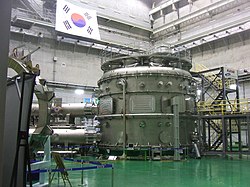 |
| LTX (Lithium Tokamak Experiment) | Operational | 2005–2008 | 2008– |  Princeton Princeton | Princeton Plasma Physics Laboratory | 0.4 m/? | 0.4 T | 0.4 MA | Study Lithium in plasma walls |  |
| QUEST (Q-shu University Experiment with Steady-State Spherical Tokamak) [36] [37] | Operational | | 2008– |  Kasuga Kasuga | Kyushu University | 0.68 m/0.4 m | 0.25 T | 0.02 MA | Study steady state operation of a Spherical Tokamak |  |
| Kazakhstan Tokamak for Material testing (KTM) | Operational | 2000–2010 | 2010– |  Kurchatov Kurchatov | National Nuclear Center of the Republic of Kazakhstan | 0.86 m/0.43 m | 1 T | 0.75 MA | Testing of wall and divertor | |
| ST25-HTS [38] | Operational | 2012–2015 | 2015– |  Culham Culham | Tokamak Energy Ltd | 0.25 m/0.125 m | 0.1 T | 0.02 MA | Steady state plasma |  |
| WEST (Tungsten Environment in Steady-state Tokamak) | Operational | 2013–2016 | 2016– |  Cadarache Cadarache | Département de Recherches sur la Fusion Contrôlée | 2.5 m/0.5 m | 3.7 T | 1 MA | Superconducting tokamak with active cooling |  |
| ST40 [39] | Operational | 2017–2018 | 2018– |  Didcot Didcot | Tokamak Energy Ltd | 0.4 m/0.3 m | 3 T | 2 MA | First high field spherical tokamak, reached 100 MK plasma |  |
| MAST-U (Mega-Ampere Spherical Tokamak Upgrade) [40] | Operational | 2013–2019 | 2020– |  Culham Culham | United Kingdom Atomic Energy Authority | 0.85 m/0.65 m | 0.92 T | 2 MA | Test new exhaust concepts for a spherical tokamak | |
| HL-3 / HL-2M (Huan-Liuqi-2M) [41] | Operational | 2018–2019 | 2020– |  Leshan Leshan | Southwestern Institute of Physics | 1.78 m/0.65 m | 2.2 T | 1.2 MA | Elongated plasma with 200 MK |  |
| JT-60SA (Japan Torus-60 super, advanced) [42] | Operational | 2013–2020 | 2021– |  Naka Naka | Japan Atomic Energy Research Institute | 2.96 m/1.18 m | 2.25 T | 5.5 MA | Optimise plasma configurations for ITER and DEMO with full non-inductive steady-state operation |  |
| T-15MD | Operational | 2010–2020 | 2021– |  Moscow Moscow | Kurchatov Institute | 1.48 m/0.67 m | 2 T | 2 MA | Hybrid fusion/fission reactor | 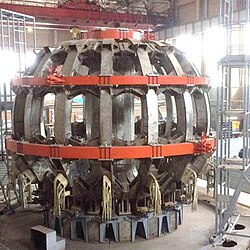 |
| IGNITOR [43] | Cancelled 2022 [44] | - | - |  Troitzk Troitzk | ENEA | 1.32 m/0.47 m | 13 T | 11 MA | Compact fusion reactor with self-sustained plasma and 100 MW of planned fusion power | |
| HH70 (HongHuang 70) [45] [46] | Operational | 2022–2024 | 2024– |  Shanghai Shanghai | Energy Singularity | 0.75 m/0.31 m | 2.5 T | | REBCO High-temperature superconducting coils | |
| SPARC [47] [48] [49] [50] [51] | Under construction | 2021– | 2026? |  Devens, MA Devens, MA | Commonwealth Fusion Systems and MIT Plasma Science and Fusion Center | 1.85 m/0.57 m | 12.2 T | 8.7 MA | Compact, high-field tokamak with ReBCO coils and 100 MW planned fusion power |  |
| ITER [52] | Under construction | 2013–2034? | 2034? |  Cadarache Cadarache | ITER Council | 6.2 m/2.0 m | 5.3 T | 15 MA ? | Demonstrate feasibility of fusion on a power-plant scale with 500 MW fusion power |  |
| Burning Plasma Experimental Superconducting Tokamak (BEST) [53] [54] | Under construction | 2023–2027? | 2027? |  Hefei Hefei | Institute of Energy, Hefei Comprehensive National Science Center | 3.6 m/1.1 m | 6.15 T ? | 7 MA ? | Intermediate step between EAST and CFETR | |
| DTT (Divertor Tokamak Test facility) [55] [56] [57] | Planned | 2022–2029? | 2029? |  Frascati Frascati | ENEA | 2.19 m/0.70 m | 5.85 T ? | 5.5 MA ? | Superconducting tokamak to study power exhaust | |
| SST-2 (Steady State Tokamak-2) [58] | Planned | | 2027? |  Gujarat Gujarat | Institute for Plasma Research | 4.42 m/1.47 m | 5.42 T | 11.2 MA | Full-fledged fusion reactor with tritium breeding and up to 500 MW output | |
| CFETR (China Fusion Engineering Test Reactor) [59] | Planned | ≥2024 | 2030? |  | Institute of Plasma Physics, Chinese Academy of Sciences | 7.2 m/2.2 m ? | 6.5 T ? | 14 MA ? | Bridge gaps between ITER and DEMO, planned fusion power 1000 MW | |
| ST-F1 (Spherical Tokamak - Fusion 1) [60] | Planned | 2027? | |  Didcot Didcot | Tokamak Energy Ltd | 1.4 m/0.8 m ? | 4 T | 5 MA | Spherical tokamak with Q=3 and hundreds of MW planned electrical output (no longer mentioned by company as of 2024) | |
| STX (ST80-HTS) | Planned | 2026? | 2030? |  Culham Culham | Tokamak Energy Ltd | | | | Spherical tokamak capable of 15min-pulsed operation [61] [62] | |
| ST-E1 | Planned | 2030s? | |  Culham Culham | Tokamak Energy Ltd | | | | Spherical tokamak with 200 MW planned net electric output [63] | |
| STEP (Spherical Tokamak for Energy Production) | Planned | 2032-2040 | 2040 D-D
Mid 2040s DT Campaign |  West Burton, Nottinghamshire West Burton, Nottinghamshire | United Kingdom Atomic Energy Authority | 3 m/2 m ? | ? | 16.5 MA ? | Spherical tokamak with 100 MW planned electrical output [64] | |
| JA-DEMO | Planned | 2030? | 2050? |  | ? | 8.5 m/2.4 m [65] | 5.94 T | 12.3 MA | Prototype for development of Commercial Fusion Reactors 1.5–2 GW Fusion output. [66] | |
| K-DEMO (Korean fusion demonstration tokamak reactor) [67] | Planned | 2037? | |  | National Fusion Research Institute | 6.8 m/2.1 m | 7 T | 12 MA ? | Prototype for the development of commercial fusion reactors with around 2200 MW of fusion power |  |
| DEMO (DEMOnstration Power Station) | Planned | 2040? | 2050? | ? | | 9 m/3 m ? | 6 T ? | 20 MA ? | Prototype for a commercial fusion reactor |  |








































